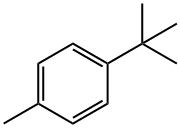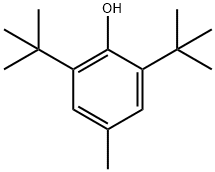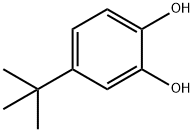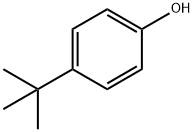4-tert-Butyltoluene
- CAS NO.:98-51-1
- Empirical Formula: C11H16
- Molecular Weight: 148.24
- MDL number: MFCD00008837
- EINECS: 202-675-9
- SAFETY DATA SHEET (SDS)
- Update Date: 2025-01-27 09:38:02

What is 4-tert-Butyltoluene?
Description
p-tert-Butyltoluene is a colorless liquid withan aromatic gasoline-like odor. Molecular weight = 148.18;Boiling point = 193-194℃; Boiling point = 193℃;Freezing/Melting point = - 52℃; Vapor pressure =0.68 mmHg at 20℃; Flash point = 68℃. HazardIdentification (based on NFPA-704 M Rating System):Health 2, Flammability 2, Reactivity 0. Insoluble in water.
Chemical properties
colourless liquid
The Uses of 4-tert-Butyltoluene
4-tert-Butyltoluene is used as pharmaceutical intermediate, Solvent for resins, intermediate in organic synthesis. It is an intermediate for the production of the acaricide pyridaben.
Preparation
Synthesis of 4-tert-butyltoluene: Put toluene in the reaction kettle, add catalyst, then add tert-butane chloride, after the reaction, wash with water and layer, and the organic layer is distilled to obtain the product. Alkylation of isobutylene and toluene in the presence of sulfuric acid can also be used to produce 4-tert-butyltoluene.
Synthesis Reference(s)
Synthetic Communications, 21, p. 1273, 1991 DOI: 10.1080/00397919108021046
General Description
Clear colorless liquid with an aromatic gasoline-like odor.
Air & Water Reactions
Flammable. Insoluble in water.
Reactivity Profile
4-tert-Butyltoluene may react with oxidizing materials.
Hazard
Toxic by inhalation, ingestion, and skin absorption. Eye and upper respiratory tract irritant.
Health Hazard
p-tert-Butyl toluene is an irritant of the mucous membranes, a central nervous system depressant and may cause cardiovascular and hematologic disturbances; chronic exposure in animals causes lung, brain, liver, and kidney damage.
Fire Hazard
4-tert-Butyltoluene is combustible.
Safety Profile
Moderately toxic by inhalation and ingestion. A skin and human eye irritant. Human systemic effects by inhalation: nausea or vomiting, conjunctiva irritation, unspecified effects on the sense of taste. Inhalation of vapors causes irritation of lungs and depression of central nervous system. Prolonged exposure may result in damage to liver and kidneys. Flammable when exposed to heat or flame. Incompatible with oxidizing materials. When heated to decomposition it emits acrid smoke and fumes.
Potential Exposure
Human Data;Primary Irritant. This material is used as a solvent for resinsand as an intermediate in organic synthesis.
First aid
If this chemical gets into the eyes, remove anycontact lenses at once and irrigate immediately for at least15 min, occasionally lifting upper and lower lids. Seekmedical attention immediately. If this chemical contactsthe skin, remove contaminated clothing and wash immediately with soap and water. Seek medical attention immediately. If this chemical has been inhaled, remove fromexposure, begin rescue breathing (using universal precautions, including resuscitation mask) if breathing hasstopped and CPR if heart action has stopped. Transferpromptly to a medical facility. When this chemical hasbeen swallowed, get medical attention. Give large quantities of water and induce vomiting. Do not make an unconscious person vomit.
Carcinogenicity
p-tert-Butyl toluene was not mutagenic in a number of bacterial strains in the Ames assay with or without metabolic activation.
storage
Color Code—Blue: Health Hazard/Poison: Storein a secure poison location. Prior to working with thischemical you should be trained on its proper handling andstorage. Store in tightly closed containers in a cool, wellventilated area. Sources of ignition, such as smoking andopen flames, are prohibited where this chemical is used,handled, or stored in a manner that could create a potentialfire or explosion hazard.
Shipping
Butyltoluenes require a “POISONOUS/TOXICMATERIALS” label. They fall in Hazard Class 6.1 andPacking Group III.[19, 20]
Purification Methods
A sample containing 5% of the meta-isomer is purified by selective mercuration. Fractional distillation of the solid arylmercuric acetate, after removal from the residual hydrocarbon, gives pure p-tert-butyltoluene [Stock & Brown J Am Chem Soc 81 5615 1959]. [Beilstein 5 H 439, 5 III 1003, 5 IV 1079.]
Incompatibilities
Forms explosive mixture with air. Reactswith strong oxidizers. May accumulate static electricalcharges and may cause ignition of its vapors
Properties of 4-tert-Butyltoluene
| Melting point: | -54 °C |
| Boiling point: | 191 °C (lit.) |
| Density | 0.858 g/mL at 25 °C (lit.) |
| vapor pressure | 1.3hPa at 30℃ |
| refractive index | n |
| Flash point: | 150 °F |
| storage temp. | Flammables area |
| solubility | 0.06 g/100 mL (20°C) |
| form | Liquid |
| color | Clear colorless to faint yellow |
| explosive limit | 0.7-7%(V) |
| Water Solubility | 0.06 g/100 mL (20 ºC) |
| BRN | 2038670 |
| Exposure limits | ACGIH: TWA 1 ppm OSHA: TWA 10 ppm(60 mg/m3) NIOSH: IDLH 100 ppm; TWA 10 ppm(60 mg/m3); STEL 20 ppm(120 mg/m3) |
| Dielectric constant | 2.3300000000000001 |
| Stability: | Stable. Combustible. Incompatible with strong oxidizing agents. |
| CAS DataBase Reference | 98-51-1(CAS DataBase Reference) |
| NIST Chemistry Reference | 4-Tert-butyltoluene(98-51-1) |
| EPA Substance Registry System | p-tert-Butyltoluene (98-51-1) |
Safety information for 4-tert-Butyltoluene
| Signal word | Warning |
| Pictogram(s) |
 Flame Flammables GHS02  Exclamation Mark Irritant GHS07  Environment GHS09 |
| GHS Hazard Statements |
H226:Flammable liquids H315:Skin corrosion/irritation H319:Serious eye damage/eye irritation H335:Specific target organ toxicity, single exposure;Respiratory tract irritation H411:Hazardous to the aquatic environment, long-term hazard |
| Precautionary Statement Codes |
P210:Keep away from heat/sparks/open flames/hot surfaces. — No smoking. P273:Avoid release to the environment. P301+P312:IF SWALLOWED: call a POISON CENTER or doctor/physician IF you feel unwell. P303+P361+P353:IF ON SKIN (or hair): Remove/Take off Immediately all contaminated clothing. Rinse SKIN with water/shower. P305+P351+P338:IF IN EYES: Rinse cautiously with water for several minutes. Remove contact lenses, if present and easy to do. Continuerinsing. |
Computed Descriptors for 4-tert-Butyltoluene
| InChIKey | QCWXDVFBZVHKLV-UHFFFAOYSA-N |
New Products
Methyl (R)-1-Boc-4,4-difluoropyrrolidine-2-carboxylate 2,2-Difluoropropylamine hydrochloride tert-butyl 3-bromoazetidine-1-carboxylate (R)-1-Boc-3-hydroxypyrrolidine DIFLUOROACETIC ANHYDRIDE 2,2-Difluoropropionic acid Diallylamine, 99% Calcium hydroxide, 95% Aluminum oxide, basic 2-Bromophenylacetonitrile, 97% L-tert-Leucine,97% N-Hydroxy-2-methylpropanimidamide 4-(3,4-Dichlorophenyl)-3,4-Dihydro-N-Methyl-1-(2H)-Naphthalenimine (Schiff Base) 2-AMINO-3,5-DIBROMO BENZALDEHYDE [ADBA] L-Glutamic Acid Dimethyl Ester Hcl 10-Methoxy-5H-dibenz[b,f]azepine 5-Cyanophthalide N, N-Carbonyldiimidazole (CDI) Dibenzoyl Peroxide Titanium Dioxide 2-(Methylthio) Benzonitrile Sodium Acetate Anhydrous Allopurinol 1,5-DibromopentaneRelated products of tetrahydrofuran








You may like
-
 4-tert-Butyltoluene CAS 98-51-1View Details
4-tert-Butyltoluene CAS 98-51-1View Details
98-51-1 -
 4-tert-Butyltoluene CAS 98-51-1View Details
4-tert-Butyltoluene CAS 98-51-1View Details
98-51-1 -
![Cis-2-(Bromomethyl)-2-(2,4-Dichlorophenyl)-1,3-Dioxolane-4-Ylmethyl Benzoate [CBB] 61397-56-6 99%](https://img.chemicalbook.in//Content/image/CP5.jpg) Cis-2-(Bromomethyl)-2-(2,4-Dichlorophenyl)-1,3-Dioxolane-4-Ylmethyl Benzoate [CBB] 61397-56-6 99%View Details
Cis-2-(Bromomethyl)-2-(2,4-Dichlorophenyl)-1,3-Dioxolane-4-Ylmethyl Benzoate [CBB] 61397-56-6 99%View Details
61397-56-6 -
 Ethyl-2-Chloroacetoacetate 609-15-4View Details
Ethyl-2-Chloroacetoacetate 609-15-4View Details
609-15-4 -
 CIS- BROMO BENZOATEView Details
CIS- BROMO BENZOATEView Details
61397-56-6 -
 609-15-4View Details
609-15-4View Details
609-15-4 -
![1-(6-Methylpyridin-3-Yl)-2-[4-(Methylsulfonyl)Phenyl]Ethanone [Ketosulfone] 99%](https://img.chemicalbook.in//Content/image/CP5.jpg) 1-(6-Methylpyridin-3-Yl)-2-[4-(Methylsulfonyl)Phenyl]Ethanone [Ketosulfone] 99%View Details
1-(6-Methylpyridin-3-Yl)-2-[4-(Methylsulfonyl)Phenyl]Ethanone [Ketosulfone] 99%View Details
221615-75-4 -
 27143-07-3View Details
27143-07-3View Details
27143-07-3
